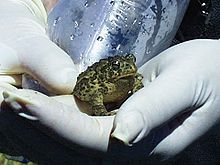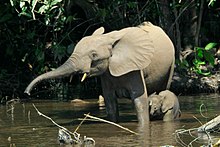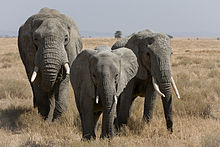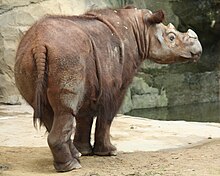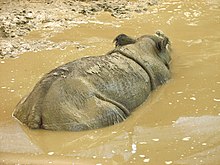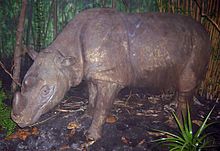The
yak (
Bos grunniens for the domesticated,
Bos mutus for the wild animal ) is a long-haired bovine found throughout the Himalayan region of south Central Asia, the Tibetan Plateau and as far north as Mongolia and Russia.
In addition to a large domestic population, there is a small,
vulnerable wild yak population. In the 1990s, a concerted effort was
undertaken to help save the wild yak population.
Etymology
The English word "yak" derives from the Tibetan (Tibetan: Wylie:
g.yag), or
gyag – in Tibetan this refers only to the male of the species, the female being called a
dri or
nak. In English, as in most other languages which have borrowed the word, "yak" is usually used for both sexes.
Taxonomy
Yaks belong to the genus
Bos, and are therefore related to cattle (
Bos primigenius taurus, Bos primigenius indicus). Mitochondrial DNA analyses to determine the evolutionary history of yaks have been somewhat ambiguous.
The yak may have diverged from cattle at any point between one and
five million years ago, and there is some suggestion that it may be more
closely related to bison than to the other members of its designated genus. Apparent close fossil relatives of the yak, such as
Bos baikalensis, have been found in eastern Russia, suggesting a possible route by which yak-like ancestors of the modern American bison could have entered the Americas.
The species was originally designated as
Bos grunniens ("grunting ox") by Linnaeus in 1766, but this name is now generally only considered to refer to the domesticated form of the animal, with
Bos mutus ("mute ox") being the preferred name for the wild species. Although some authors still consider the wild yak to be a subspecies,
Bos grunniens mutus, the ICZN made an official ruling in 2003 permitting the use of the name
Bos mutus for wild yaks, and this is now the more common usage.
Except where the wild yak is considered as a subspecies of
Bos grunniens, there are no recognised subspecies of yak.
Physical characteristics

Domestic yak at Yumdrok Yumtso Lake
Wild yaks are among the largest bovids and are second only to the gaur
in shoulder height. Wild yak adults stand about 1.6 to 2.2 m (5.2 to
7.2 ft) tall at the shoulder and weigh 305–1,000 kg (670–2,200 lb). The
head and body length is 2.5 to 3.3 m (8.2 to 11 ft), not counting the
tail of 60 to 100 cm (24 to 39 in). The females are about one-third the
weight and are about 30% smaller in their linear dimensions when
compared to bull wild yaks. Domesticated yaks are much smaller, males weighing 350 to 580 kg (770 to 1,300 lb) and females 225 to 255 kg (500 to 560 lb).
Yaks are heavily built animals with a bulky frame, sturdy legs, and
rounded cloven hooves. They are the only wild bovids of this size with
extremely dense, long fur that hangs down lower than the belly. Wild
yaks are generally dark, blackish to brown, in pelage coloration.
However, domestic yaks can be quite variable in color, often having
patches of rusty brown and cream. They have small ears and a wide
forehead, with smooth horns that are generally dark in colour. In males,
the horns sweep out from the sides of the head, and then curve forward;
they typically range from 48 to 99 cm (19 to 39 in) in length. The
horns of females are smaller, only 27 to 64 cm (11 to 25 in) in length,
and have a more upright shape. Both sexes have a short neck with a
pronounced hump over the shoulders, although this is larger and more
visible in males.
Yaks are highly friendly in nature and can easily be trained. There has
been very little documented aggression from yaks towards human beings,
although mothers can be extremely protective of their young and will
bluff charge if they feel threatened.
Both sexes have long shaggy hair with a dense woolly undercoat over
the chest, flanks, and thighs to insulate them from the cold. Especially
in males, this may form a long "skirt" that can reach the ground. The
tail is long and horselike rather than tufted like the tails of cattle
or bison. Wild yaks typically have black or dark brown hair over most of
the body, with a greyish muzzle, although some wild golden-brown
individuals have been reported. Domesticated yaks have a wider range of
coat colours, with some individuals being white, grey, brown, roan or piebald. The udder in females and the scrotum in males are small and hairy, as protection against the cold. Females have four teats.
To the casual observer, yaks are easily confused with Highland cattle
,
but upon closer examination, the physical differences are quite
apparent. However, Highland cattle are shaggy, rather than long-haired,
and have straight backs and tufted tails.
Physiology
Yak physiology is well adapted to high altitudes, having larger lungs
and heart than cattle found at lower altitudes, as well as greater
capacity for transporting oxygen through their blood due to the persistence of foetal haemoglobin throughout life. Conversely, yaks do not thrive at lower altitudes, and begin to suffer from heat exhaustion above about
15 °C (59 °F). Further adaptations to the cold include a thick layer of subcutaneous fat, and an almost complete lack of functional sweat glands.
Compared with domestic cattle, the rumen of yaks is unusually large, relative to the omasum.
This likely allows them to consume greater quantities of low-quality
food at a time, and to ferment it longer so as to extract more
nutrients. Yak consume the equivalent of 1% of their body weight daily while cattle require 3% to maintain condition.
Odor
Contrary to popular belief, yak and their manure have little to no detectable odor
when maintained appropriately in pastures or paddocks with adequate
access to forage and water. Yak wool is naturally odor resistant.
Reproduction and life history
Yaks mate in the summer, typically between July and September,
depending on the local environment. For the remainder of the year, many
males wander in small bachelor groups away from the large herds, but, as
the rut
approaches, they become aggressive and regularly fight amongst each
other to establish dominance. In addition to non-violent threat
displays, bellowing, and scraping the ground with their horns, male yaks
also compete more directly, repeatedly charging at each other with
heads lowered or sparring with their horns. Like bison, but unlike cattle, males wallow in dry soil during the rut, often while scent-marking with urine or dung. Females enter oestrus up to four times a year, and females are receptive only for a few hours in each cycle.
Gestation lasts between 257 and 270 days,
so that the young are born between May and June, and results in the
birth of a single calf. The female finds a secluded spot to give birth,
but the calf is able to walk within about ten minutes of birth, and the
pair soon rejoin the herd. Females of both the wild and domestic forms typically give birth only once every other year, although more frequent births are possible if the food supply is good.
Calves are weaned at one year and become independent shortly
thereafter. Wild calves are initially brown in colour, and only later
develop the darker adult hair. Females generally give birth for the
first time at three or four years of age,
and reach their peak reproductive fitness at around six years. Yaks may
live for more than twenty years in domestication or captivity, although it is likely that this may be somewhat shorter in the wild.
Wild yaks

A herd of domestic yaks wandering in The Himalayas
Wild yaks (
Bos grunniens mutus or
Bos mutus, Tibetan: Wylie:
'brong)
usually form herds of between ten and thirty animals. They are
insulated by dense, close, matted under-hair as well as their shaggy
outer hair.
Yaks secrete a special sticky substance in their sweat which helps keep
their under-hair matted and acts as extra insulation. This secretion is
used in traditional Nepalese medicine. Many wild yaks are killed for food by hunters in China; they are now a vulnerable species.
The diet of wild yaks consists largely of grasses and sedges, such as
Carex,
Stipa, and
Kobresia. They also eat a smaller amount of herbs, winterfat shrubs, and mosses, and have even been reported to eat lichen. Historically, the main natural predator of the wild yak has been the Tibetan wolf, but brown bears and snow leopards have also been reported as predators in some areas, likely of young or infirm wild yaks.
Thubten Jigme Norbu, the elder brother of Tenzin Gyatso, the 14th Dalai Lama, reported on his journey from Kumbum in Amdo to Lhasa in 1950:
Before long I was to see the vast herds of drongs
with my own eyes. The sight of those beautiful and powerful beasts who
from time immemorial have made their home on Tibet's
high and barren plateaux never ceased to fascinate me. Somehow these
shy creatures manage to sustain themselves on the stunted grass roots
which is all that nature provides in those parts. And what a wonderful
sight it is to see a great herd of them plunging head down in a wild
gallop across the steppes. The earth shakes under their heels and a vast
cloud of dust marks their passage. At nights they will protect
themselves from the cold by huddling up together, with the calves in the
centre. They will stand like this in a snow-storm, pressed so close
together that the condensation from their breath rises into the air like
a column of steam. The nomads have occasionally tried to bring up young
drongs as domestic animals, but they have never entirely succeeded.
Somehow once they live together with human beings they seem to lose
their astonishing strength and powers of endurance; and they are no use
at all as pack animals,
because their backs immediately get sore. Their immemorial relationship
with humans has therefore remained that of game and hunter, for their
flesh is very tasty.
—Thubten Norbu, Tibet is My Country
Distribution and habitat
Wild yaks are found primarily in northern Tibet and western Qinghai, with some populations extending into the southernmost parts of Xinjiang, and into Ladakh
in India. Small, isolated populations of wild yak are also found
farther afield, primarily in western Tibet and eastern Qinghai. In
historic times, wild yaks were also found in Nepal and Bhutan, but they are now considered extinct in both countries, except as domesticated animals.
The primary habitat of wild yaks consists of treeless uplands between 3,000 and 5,500 m (9,800 and 18,000 ft), dominated by mountains and plateaus. They are most commonly found in alpine meadows with a relatively thick carpet of grasses and sedges, rather than the more barren steppe country.
Behaviour
Yaks are herd animals. Herds can contain several hundred individuals, although many are much smaller. The herds
consist primarily of females and their young, with a smaller number of
adult males. The remaining males are either solitary, or found in much
smaller groups, averaging around six individuals. Although they can
become aggressive when defending young, or during the rut, wild yaks generally avoid humans, and may rapidly flee for great distances if any approach.
Domesticated yaks
Domesticated yaks have been kept for thousands of years, primarily for their milk, fibre and meat, and as beasts of burden.
Their dried dung is an important fuel, used all over Tibet, and is
often the only fuel available on the high treeless Tibetan plateau. Yaks
transport goods across mountain passes for local farmers and traders as
well as for climbing and trekking expeditions. "Only one thing makes it
hard to use yaks for long journeys in barren regions. They will not eat
grain, which could be carried on the journey. They will starve unless
they can be brought to a place where there is grass." They also are used to draw ploughs. Yak milk is often processed to a cheese called
chhurpi in Tibetan and Nepali languages, and
byaslag in Mongolia. Butter made of Yaks' milk is an ingredient of the butter tea that Tibetans consume in large quantities, and is also used in lamps and made into butter sculptures used in religious festivities. Yaks grunt, and unlike cattle are not known to produce the characteristic bovine lowing sound.
Yak sports
In parts of Tibet and Karakorum yak racing
is a form of entertainment at traditional festivals and is considered
an important part of their culture. More recently, sports involving
domesticated yaks, such as yak skiing, or yak polo, are being marketed as tourist attractions in Central Asian countries, including Gilgit–Baltistan, Pakistan.
Hybrid yak
In Nepal, Tibet and Mongolia, domestic cattle are crossbred with yaks. This gives rise to the infertile male dzo as well as fertile females known as
dzomo or
zhom, which may be crossed again with cattle. The "Dwarf Lulu" breed, "the only
Bos primigenius taurus type of cattle in Nepal" has been tested for DNA markers and found to be a mixture of both taurine and zebu types of cattle (
B. p. taurus and
B. p. indicus) with yak. According to the International Veterinary Information Service, the low productivity of second generation cattle-yak crosses makes them suitable only as meat animals.
Crosses between yaks and domestic cattle (
Bos primigenius taurus) have been recorded in Chinese literature for at least 2,000 years. Successful crosses have also been recorded between yak and American bison, gaur, and banteng, generally with similar results to those produced with domestic cattle.

.jpg)
